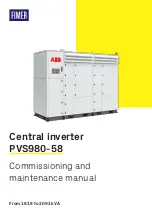
Days
ago
Yield
(Wh)
Max.
PV
power
(W)
Max.
PV
voltage
(V)
Min.
battery
voltage
(V)
Max.
battery
voltage
(V)
Time in
bulk(m)
Time in
absorp.
(m)
Time
in
float
(m)
Last
error
2nd
last
error
3rd
last
error
4th
last
error
0
14500
2167
118.80
51.34
52.99
748
0
0
0
0
0
0
1
15450
2326
118.81
51.68
53.97
869
0
0
0
0
0
0
2
12350
2925
126.67
51.73
55.42
872
0
0
0
0
0
0
Battery Voltage
The first figure shows the maximum battery voltage for the day …the figure below is the minimum battery voltage.
Errors
Shows the number of errors (if any) for the day, to see the error codes click on the orange point. See
. (You may need to slide the display on your device up to see the errors.)
Total
This shows the total energy converted by the installation and is not re-settable.
Since Cleared
This shows how much energy has been converted by the installation since the last reset.
4.4. Protections and automatic restarts
4.4.1. Overload
Some loads like motors or pumps draw large inrush currents during start-up. In such circumstances, it is possible that the start-up
current exceeds the over current limit of the inverter. In this case the output voltage will quickly decrease to limit the output current
of the inverter. If the over current limit is continuously exceeded, the inverter will shut down for 30 seconds and then automatically
restart. After three restarts followed by overload within 30 seconds of restarting, the inverter will shut down and remain off. To
restart normal operation, disconnect the load, Switch Off the inverter, then switch it On.
4.4.2. Low battery voltage thresholds (adjustable in VictronConnect)
The inverter will shut down when the DC input voltage drops below the low battery shutdown level. After a minimum shutdown
time of 30 seconds, the inverter will restart if the voltage has risen above the low battery restart level.
After three shut down and restarts, followed by a low battery shutdown within 30 seconds of restarting, the inverter will shut down
and stop retrying based on the low battery restart level. To override this and restart the inverter, switch it Off, and then On, and
limit loads to enable recharging of the battery with solar energy.
The solar MPPT will continue to recharge the battery even when the inverter has shut down due to low battery voltage. If the
inverter has shut down 4 times, it will again attempt to switch itself back on as soon as the DC voltage stays above the Charge
Detect level for 30 seconds.
See the Technical Data table for default low battery shut down, restart and charge detect levels. They can be adjusted with
VictronConnect (computer or app).
Additionally another external MPPT or battery charger can also be used to recharge the battery to reach the Restart Voltage or
Charge Detect voltage level. !!! If using the allow to charge signal functionality, it must remain above the minimum voltage, so if
the battery is completely dead it will not allow charging to start. In this case, you can temporarily disable this function in
VictronConnect to allow charging to resume, then enable it again.
See the Technical Data table for default low battery shut down and restart levels. They can be changed with VictronConnect
(computer or app). Alternatively Dynamic Cut-off can be implemented, see
https://www.victronenergy.com/live/ve.direct:phoenix-
4.4.3. High battery voltage
Reduce DC input voltage and/or check for a faulty battery- or solar-charger in the system. After shutting down due to a high
battery voltage, the unit will first wait 30 seconds and then retry operation as soon as the battery voltage has dropped to
acceptable level.
Inverter RS Smart
Page 16
Operation












































